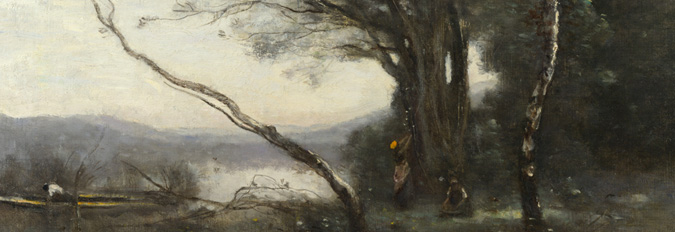Subject
The right side of 'The Leaning Tree Trunk' is dominated by a dense mass of foliage and the gnarled trunk of a tree, some of whose branches twist to the left. Two single trunks stand in the foreground; that on the right bends gracefully, while that on the left reaches right out across the picture. In the background is a lake. There are three figures: a boatman in his boat, a woman gathering twigs from the tree and another woman sitting under the tree.
'The Leaning Tree Trunk' is very closely related to a painting in the National Gallery of Victoria, Melbourne, 'The Bent Tree (Morning) (Ville d’Avray, Bouleau Pond)' (R1122) (fig. 2), which, like NG 2625, was formerly in the collection of the accountant Alexander Young4. The paintings differ only in that the Melbourne picture includes a cow at the right and buildings on the far side of the lake.
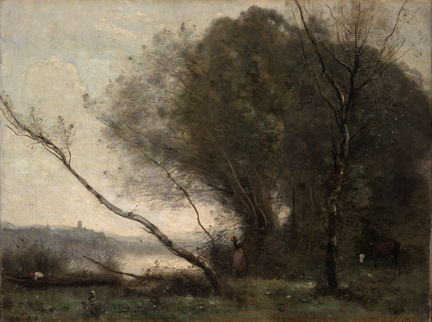
© National Gallery of Victoria, Melbourne, Australia. Felton Bequest (338-2 ) / Bridgeman Art Library
The basic composition shared by these two works is to be found in a number of other paintings, including: Ville d’Avray. 'Lake with the Leaning Tree Trunk' (R1497, Reims, Musée des Beaux-Arts; fig. 3); 'Ville d’Avray. Lake with the Leaning Tree Trunk' (R1498, Evening sale, Christie’s, 24 June 2008, lot 21); 'Lake with the Leaning Tree Trunk' (R1980, location unknown) and 'Lake with the Leaning Tree Trunk: Souvenir of Castel Gandolfo' (R1626, Paris, Musée du Louvre).
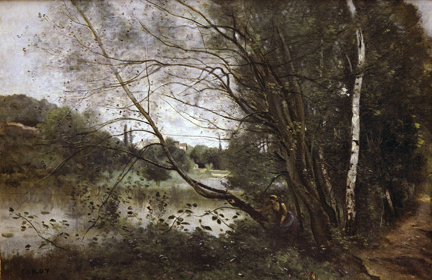
© RMN, Paris / Agence Bulloz
A drawing also in the Louvre, 'Leaning Trees on the shores of the Lake, 1855–60' (RF 4035; fig. 4), is almost certainly a study for the Melbourne picture, to which it is more closely related than to NG 26255.
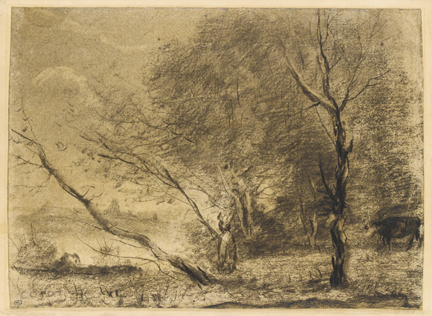
© RMN, Paris / Thierry Le Mage
A picture in the National Gallery of Art, Washington, also shares the motif of branches reaching out across the picture surface6. A number of the paintings, including the Melbourne picture, are associated with Ville d’Avray and its lake. The Reims picture is an accurate view of the lake at Ville d’Avray from the south-west, painted on the spot with the foreground of leafy trees added later in the studio, and it has generally been given first place in the series, with the view gradually transformed in subsequent versions, often with elements such as the boat and boatman added7.
What has not been previously noted is that Corot took the motif of the trees directly from a drawing he had made in 1826 during his first visit to Italy, 'Clump of Trees at Civita Castellana' (Washington, National Gallery of Art; fig. 5). The Reims painting follows the disposition of the trees in the drawing almost exactly, from the kink in the trunk arching across, with its slender off-shoots, to the upright silver birch trunk on the right, which is copied from the straight vertical trunk on the extreme right of the drawing. Both these trees are integral to the mass of intertwined trunks and foliage which dominate the right of both the (Italian) drawing and the painting.
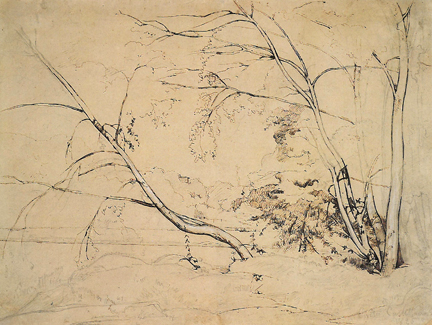
© National Gallery of Art, Washington, DC
Gift of Walter H. and Leonore Annenberg, in Honour of the 50th Anniversary of the
National Gallery of Art (1990.47.1)
By the time Corot painted NG 2625 and the Melbourne picture, the two single tree-trunks have broken away from the rest of the trees to stand in front as two separate decorative elements in the composition. Both have become more stylised, and the trunk leaning across has lost its off-shoots. The lake setting has also become more generic in 'The Leaning Tree Trunk', as in other paintings of the series, with the buildings suppressed.

